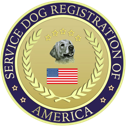Do Service Dogs Have To Wear A Vest? [Expert’s Answer]
2023-04-11Service dogs are an invaluable asset to many people with disabilities. They’re more than just man’s best friend – many handlers rely on their dogs to navigate their daily lives. These furry companions are often seen wearing vests that identify them as official service dogs. Here, we discuss the ins and outs of these vests.
Does Your Service Dog Have To Wear Vests in Public?
Service dogs are highly intelligent animals trained specifically to help their handler with specific tasks. This can come in many forms, such as seeing-eye dogs for people with visual impairment or medial alert dogs for others with certain medical conditions.
Some service animals are on duty 24/7, even when their handlers are at home. Others only work when their owners go out, such as when they go to work or the store.
Many official dogs often wear vests to identify themselves when they’re out in public. While some people believe these vests are required, this is actually not true. The Americans With Disabilities Act (ADA) does not require a service dog to wear a vest, tag, or any form of identification.
The ADA included this stipulation to help avoid discrimination against people for using a service dog. However, there are several reasons why you may want to have your dog wear a vest when out in public.
Should Service Dogs Wear a Vest?
While having your dog wear a vest when it’s working in public is not required, it is a highly good idea. Wearing a vest makes it easier for your dog to enter public spaces where non-working animals aren’t allowed, such as stores and restaurants.
Working vests can also help the public interface with your pooch more easily. Many people get excited when they see a dog and may try to pet it without thinking. Vests with labels like “Service Animal – Do Not Pet” or “Don’t Pet Me, I’m Working” go a long way to keep people from bothering your furry friend when they’re on duty.
As someone with a service dog, you could also use a vest to carry important information. Many handlers have service dogs trained to help with specific medical conditions. They may also train to alert or seek help in the event of a medical episode. For these dogs, it can be a good idea to wear a vest with pockets that can carry medical information and instructions that other people can use to help in an emergency.
Can’t Everyone Call Their Dog Service Dog?
No. The Americans with Disabilities Act states that in order to be classified as a service dog, the animal must meet two main criteria. First, the dog has to be trained to do tasks for people with disabilities. In practice, that means the dog must be able to perform at least one task.
The second criterion is that they must be able to perform tasks specifically related to the handler’s disability. A handler or caretaker may train a dog to sit or stay, but unless these tasks are specific to aiding with their owner’s disability, they don’t count.
It’s important to note that emotional support or therapy dogs do not meet these criteria and therefore do not classify as service animals. There are different policies for therapy and ESA dogs.
A dog that fails to meet these criteria is not a service dog. There are several reasons why you can’t call any furry companion a service animal:
- Lack of training – Service dogs undergo long and intense training before they go home with their handlers. This training includes how to behave safely in public spaces where there may be many other distracting people and animals. Dogs without this training may act aggressively toward actual service animals, making it unsafe for the handler to be in that space.
- Influencing public perception – While it’s illegal to discriminate against people for using legitimate service dogs, handlers and their canine companions still face a lot of prejudice. Public perception of – and prejudice against – actual service dogs can be negatively influenced by seeing the behavior of a fake service dog.
Currently, no laws prevent someone from dressing their dog in a service vest, even if they aren’t service animals. However, doing this can give actual service dogs a bad reputation and make life more difficult for them and their handlers.
Why Service Dog Vests Are Important
Even though they aren’t required, service vests can make a big difference for both the dog and its handler. Here are some main reasons vests are so important when your service pup is out and about.
Public Trust
It can be easy to forget that a lot of people have a fear of dogs. They might react badly to seeing one out in public spaces. Wearing a vest can help alleviate some of the fear because it shows that the dog is well-mannered, well-trained, and has a legal right to be there.
Avoid Distractions
On the opposite end of the spectrum, many people love meeting new dogs. They may try to approach or pet your dog, especially if they don’t realize the dog is working. Wearing a vest shows that the dog is currently on duty, and many people know this means they shouldn’t bother or distract the dog.
Working Cues
Wearing a vest can help the dog differentiate between being “on duty” and “off duty”. You can think of it as a work uniform, and many handlers use this as a cue for their animals to signal when it’s time to work and when it’s time to relax.
Register Your Service Dog with SDRA Today!
Your pup works hard; we’ve got resources that can help make their job a little easier. Register with SDRA today! We’re a leading service animal authority, and we’re here to support you and your furry companion each step of the way!
